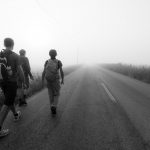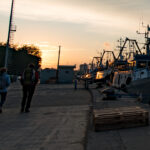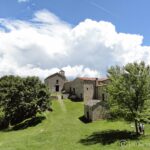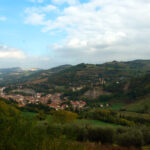Distance: 19 Km
Estimated time: 4 h
Departure: Quartolo
Stages: Church of Santa Maria di Quartolo, Dominican Monastery of Fognano, Sanctuary of Monticino, Pieve del Tho.
Arrival: Convent Dominican Sisters in Fognano
Description of the stage
We drive along via Firenze (sp 302) in the west direction and soon we reach a level crossing, we pass it leaving on the left via Molino del rosso, we pass the km 91 and at the 90.300 km turn right into via Montecchio.
On asphalt slightly uphill with nice view on the right of the badlands we reach a small pillar where we cross the trail CAI 505 that we will cover entirely remaining on the ridges until you reach the provincial sp 23 near the cave “tanaccia”. Turn right and after passing the restaurant “the asylum” after about 200 meters turn left into via Rontana along Cà Varnello and reached Cà il Borgo turn left to the left following the path 511 CAI that first on a convenient road then between a grove and ginestre leads us to the church of Monticino that we admire from above with a view of the castle and the clock tower. Once in the church square on the right you can go up to the basilica; we continue in steep descent in a cypress alley and we come out on the provincial road that we cover for 100 mt. Up to the castle where we take the stairs that will lead us to the historic center of Brisighella. After passing the main square we cross via Baccarini, which leads to Sp 302 and we head right towards the railway station. In front of the elementary school we cross the road to stay on a long pedestrian path that will lead us to Pieve di Thò. Turn left on asphalt up to the intersection with via Zolle that we take to the right and follow it until you reach a cabin with solar panels, here turn right on carriageway between cultivated fields and a cottage with yard, always between orchards and fields reach a comfortable ford and continue right through plantations of kiwi slightly uphill we reach another cottage and after passing it, we cross the asphalt road that we take to the right and there appears the village of Fognano. We cross a small group of houses and shortly after we cross Via Campiume that we will travel in the next stage, we instead turn right and in front of us appears the convent of the Dominican nuns where our stage ends.
Interesting sites
The archaeological finds testify how the valley of the Lamone hosted human settlements since the Neolithic age and, subsequently, also populations of Celtic origin; but it was the Roman occupation that valued it with the construction of the Via Faentina (originally Via Antonina 150 BC) traveled by caravans that brought salt from the Cervia salt pans to Rome.
The origins of the village date back to the late thirteenth century when Maghinardo Pagani, considered the greatest medieval leader of Romagna (also mentioned by Dante in the Divine Comedy) built on one of the three hills what became the most important fortified tower of the valley, at whose feet the village developed.
The historic center dominates the ancient Via del Borgo, a covered road from the 12th century, raised and lit by means of arches of different width, a bulwark of defense for the medieval citadel behind it. Famous by virtue of its very particular architecture, it is known as “Via degli Asini” for the shelter it offered to the animals of the birocciai who lived there.
In Brisighella, which gave birth to eight cardinals, the sacred buildings are numerous: the Pieve di S. Giovanni in Ottavo stands out, (or Pieve del Thò), built around the fifth century and rebuilt in a wider form ‘XI and XII, eighth mile of the ancient Roman road from Faenza to Tuscany. Its origins are very remote and make it go back to Galla Placidia, daughter of Theodosius, who had it erected with the remains of a temple dedicated to Jupiter Ammon. The era of its construction is unknown, probably arose between the eighth and tenth centuries. It is called “in eighth” because it is located at the eighth mile of the Roman road (“Via Faventina”, indicated in the Tavola Peutingeriana) that connected Faenza with Etruria.
Suggestive Romanesque-style temple, with a basilica plan, with three naves, divided by arches that rest on eleven columns and one of Verona marble columns, very different from each other as thickness and width (perhaps of material reusing an ancient pre-existing temple dedicated – as already mentioned – to the god Jupiter Ammone). The walls of the central nave, on the outside, have valuable decorations of small arches and pilasters, placed between the mullioned windows. A Roman milestone with an inscription dedicated to the four emperors of decadence (years 376-378), a slab, now a part of the central altar (VIII-IX century), a funerary stone in ceramics (XVII century), frescoes from the XIV-XVI centuries , Corinthian capital (holy water font) of the first century AD, testify to the antiquity of this “Mother Church” of the Lamone valley.
The church of Pieve Tho is open on Sundays and holidays:
from 15 April to 15 October at 15.00-18.00
from October 16th to April 14th from 2.30pm to 4.30pm
REGIONAL PARK OF THE GATE OF THE GESSO
The Regional Park of the Vena del Gesso Romagnola protects and promotes an area of great value, which stands out among the excellence of the northern Apennines and, in general, of the Italian mountains, as a rare example of a mountain range consisting exclusively of Selenitic gypsum crystals.
The protected area extends from the valley of the Lamone River to that of the Torrente Sillaro and involves the territory of six municipalities: Brisighella, Borgo Tossignano, Casalfiumanese, Casola Valsenio, Fontanelice, Riolo Terme. It crosses two provinces, Bologna and Ravenna.
GROTTE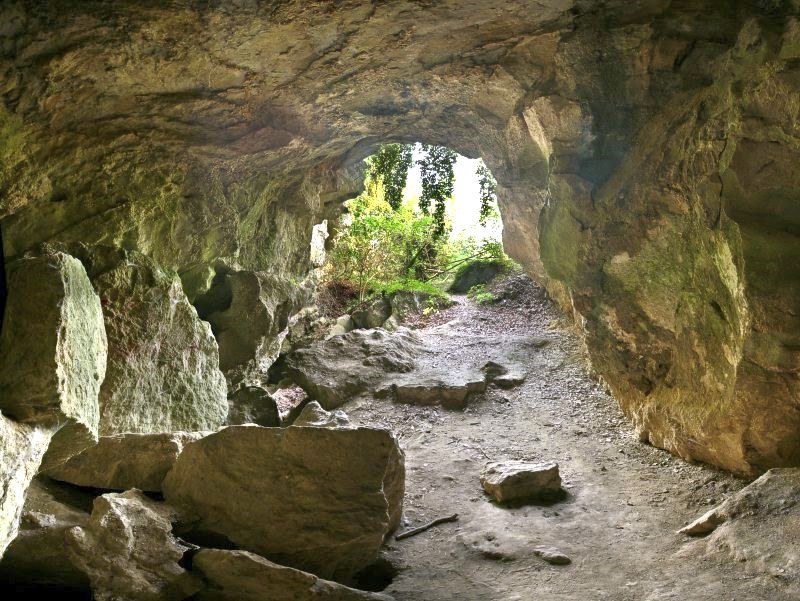
The outcrop of the Chalk of 6 million years ago, which develops in a succession of spectacular cliffs, is formed by a soluble mineral, gypsum, with a vast system of caves, sinkholes, sinkholes and resurgences, for an overall development of more than 40 km. La Vena del Gesso apart from a rock formation called “gypsum-sulphifera formation” that extends from Piedmont to Sicily but only here reaches such remarkable outcrops.
It is one of the largest chalky karst areas in Europe. The best known caves are:
Grotta Tanaccia (Brisighella) can be visited only with a speleological guide all year round, with the exception of the winter period to protect bat hibernation.
Contact person: Ivano Fabbri 339 2407028
Grotta di Re Tiberio (Riolo Terme) which can be visited with a free guide from May to September.
VISITOR CENTER: Cà Carnè (refuge)
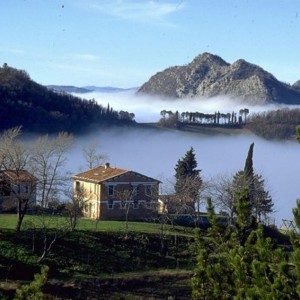
Ca ‘Carnè, visitor center and shelter of the park, is well suited to educational activities, hiking, stay in the green, at the base of knowledge and respect for nature.
Refreshments and excursions all year round, the Ca ‘Carnè shelter offers its guests a newly renovated and enlarged structure with 20 beds.
THE FORTRESS
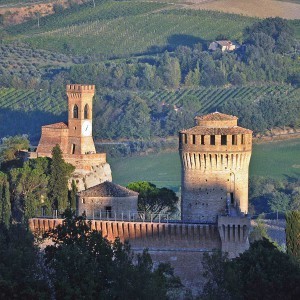
It stands on one of the three chalky pinnacles that dominate the village. Built in 1310 by the Manfredis, lords of Faenza, it remained in this family until 1500, when it passed for only three years to Cesare Borgia.
The Rocca still retains the characteristics of medieval fortresses: the holes for the chains of drawbridges above the entrance door, the corbels and the machicolations, the walkways on the walls, the loopholes. Seat of the museum dedicated to the relationship between Man and Gypsum, also in virtue of the imposing architectural setting (which was the subject of a recent restoration) and the availability of interior spaces that have remained unaltered until today.
The Man and the Gypsum Museum is a journey that goes through the long history of man’s relationship with this territory and with the mineral that characterizes it.
The staircase to the Torre Manfrediana, on the right, is a walk in history that starts from the protohistoric age of the caves of the Vena del Gesso for funeral and cult reasons, through the Roman age with the development of the extraction of precious lapis specularis (stone glass) and comes to the Middle Ages and the Renaissance, with the phenomenon of the embankment that saw the chalky ridges protagonists of the construction of fortresses and castles. The upper hall of the Manfrediana tower exposes the archaeological areas found in the Vena del Gesso and dating back to these three different phases of attendance.
CLOCK TOWER
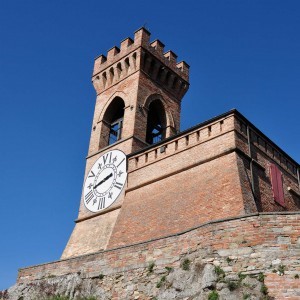
Originally it was the fort built in 1290 by Maghinardo Pagani da Susinana with squared blocks of gypsum, to check the besieged moves in the nearby castle of Baccagnano.
Until 1500 it constituted, together with the Rocca, the defensive system of the inhabited center.
Damaged and rebuilt several times, the tower was completely rebuilt in 1850 and in the same year the clock was also placed.
The clock face is six hours.
Interesting view of the ravines, a formation of blue clays, washed away by atmospheric agents.
SANCTUARY OF THE MADONNA DEL MONTICINO
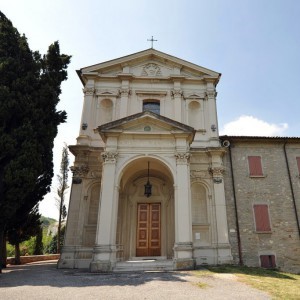
Here a sacred image in polychrome terracotta by an unknown artist is venerated, dated 1626.
In 1662 it was moved to a chapel, where today stands the Sanctuary, on the hill that was then called Monte Cozzolo or Calvario, perhaps because it is steep and steep.
In 1758 the current sanctuary was built which, over the course of time, has undergone numerous renovations.
Today’s façade was redone on a project by prof. Edoardo Collamarini in 1926 on the occasion of the III centenary of the Holy Image. The interior frescoes date back to 1854 and are the work of Faino Savino Lega.
Here a sacred image in polychrome terracotta by an unknown artist is venerated, dated 1626.
In 1662 it was moved to a chapel, where today stands the Sanctuary, on the hill that was then called Monte Cozzolo or Calvario, perhaps because it is steep and steep.
In 1758 the current sanctuary was built which, over the course of time, has undergone numerous renovations.
Today’s façade was redone on a project by prof. Edoardo Collamarini in 1926 on the occasion of the III centenary of the Holy Image. The interior frescoes date back to 1854 and are the work of Faino Savino Lega.
The four works of the Palmezzano: Church of S. Maria degli Angeli or of observance, the collegiate church of San Michele Arcangelo. (Our Lady on the throne, God the Father, Adoration of the Magi, Jesus speaks among the doctors in the temple).
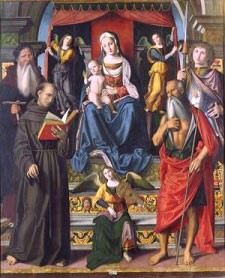
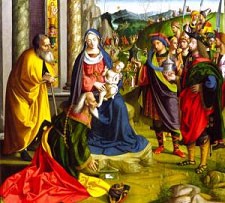
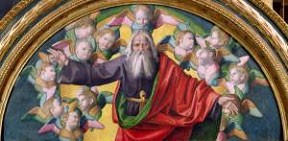
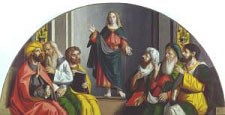
site: www.brisighella.org

